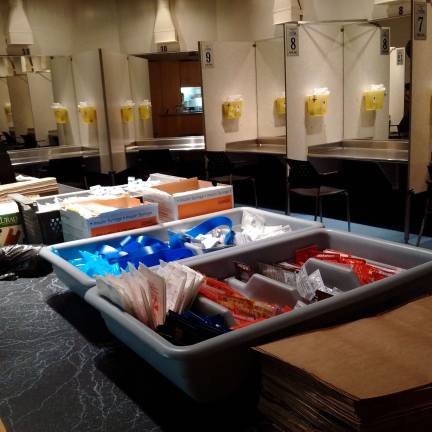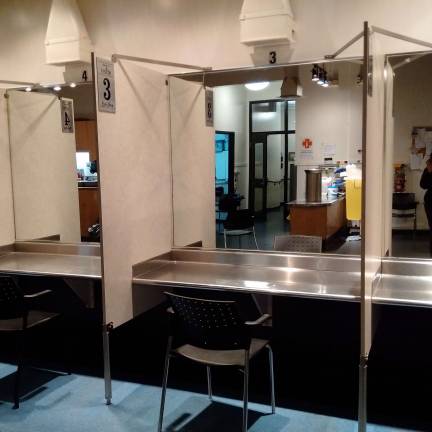U.S. looking to Canada for approach to opioid crisis



Editor’s note: This is the second installment of a two-part series looking at one of the many innovative ways different communities are fighting the opioid crisis.
BY ERIKA NORTON
VANCOUVER, B.C. — With opioid painkiller and heroin addictions leading to a surge in drug overdoses in the United States, government officials are considering a new and controversial approach used by our neighbors in the north.
In Vancouver, British Columbia, more than 3.5 million people have injected intravenous drugs at Insite, a facility where intravenous drug users are encouraged to come and shoot up under supervision of medical professionals who can intervene if the person overdoses and can connect them to onsite treatment.
The supervised injection site is the first of its kind in North America. Since it’s opening in 2003, the facility has not seen one death, according to Insite.
Insite uses the harm-reduction model — what some call an unconventional approach — which strives to reduce the adverse health, social and economic effects of drug use without requiring abstinence from drug use. The clinic is located in Vancouver’s Downtown Eastside, a 10-block radius where there is a high concentration of long-term intravenous drug users, along with individuals suffering from mental illness and homelessness.
In the two years after the facility opened, heroin overdoses dropped 35 percent in the community surrounding Insite and fell nine percent citywide.
But what would a supervised injection site look like in the states?
And would it be legally possible?
In Vancouver, Insite operates under a Health Canada exemption from prosecution under that country’s national drug laws.
But in the U.S., a provision of the federal Controlled Substances Act makes it illegal to operate facilities where drugs are used.
Possession of heroin is also illegal.
Many states also have state laws that will have to be changed to allow a supervised injection site.
But despite these hurdles, both legal and in the arena of public opinion, a number of U.S. cities, including Boston, San Francisco, New York City, and even Ithaca in upstate New York, are looking at the option of supervised injection sites.
In Seattle — a city where there is an overdose death almost every 36 hours — officials have approved $1.3 million in the 2018 budget for studying and building the nation’s first safe injection site for users of heroin and other illegal drugs, with the facility poised to open later this year.
But the move is facing steep opposition. Covington, a nearby city to Seattle, preemptively voted in November to ban a supervised injection site in their city.
‘The Ithaca Plan’Closer to home in upstate New York, the city of Ithaca is seriously exploring the operation of a supervised injection site to deal with a steep climb in overdose deaths.
Ithaca, the home to Cornell University and Ithaca College, is the county seat of Tompkins County. In less than a decade, overdose deaths have more than tripled in the county, according to data released by the city, with drug-related hospitalizations up from 14.4 per 10,000 people during 2009-2011 to now 15.5.
The use and studies of these facilities are mentioned in Ithaca’s plan to address the drug problem in the city, called “The Ithaca Plan: A Public Health and Safety Approach to Drugs and Drug Policy.”
“Heroin maintenance and supervised injection facilities, while new to the U.S., have been used in dozens of jurisdictions in Canada and Europe and would meet the demand by not requiring participants to stop drug use as a means of success,” the plan states. “Research has made clear that such interventions can lower public intoxication, stabilize users’ lives, and link a hard-to-reach population to services.”
The goals for implementing a supervised injection site, according to the plan, would be “to prevent fatal and non-fatal overdose, infectious disease, and bacterial infections; reduce public drug use and discarded needles; and provide primary care and referrals to basic services, housing, and substance use services and treatment, including the integration a basic health care provider at harm reduction sites.”
‘Addressing the problem’In the majority of the U.S., resistance from government officials has proved to be too much of a hurdle to approve supervised injection sites.
Recently sworn-in Vermont U.S. Attorney Christina Nolan said in a statement that safe injection sites “would encourage and normalize heroin use, thereby increasing demand for opiates and, by extension, risk of overdose and overdose deaths.”
Andrew McKenna, a former federal prosecutor for the Justice Department in Washington, D.C., who worked in the Narcotics and Dangerous Drugs Division, has first-hand experience with the opioid crisis, both professionally and personally. After a painkiller addiction turned into a heroin addiction, McKenna’s addiction spiralled to the point where he spent nearly six years in prison after robbing six banks and two grocery stores.
So when he first heard about supervised injection sites potentially coming to the U.S., he was skeptical.
“When I initially heard of it, it didn’t sit right with me, and I think that’s probably the reaction that a lot of people have,” McKenna said, “because my mind immediately goes to okay, a place where drug addicted people can come and hang out and share dope and do all these things. So why would we facilitate that as a community?
“But then, the rational thinking kind of kicks in,” McKenna said.
“That person is going to use heroin, whether we give them a safe place to do it or not,” he continued. “And they’re probably going to use in unsafe conditions, probably in houses where other people are using where they could be robbed, beaten, sexually molested if they were to pass out.”
Now, McKenna feels like supervised injection sites could be beneficial, especially in helping people with opioid addictions to get treatment.
“The arguments against this are, ‘Well ,aren’t we condoning this behavior?’ The behavior is happening, whether you condone it or not, and you’re not condoning it,” McKenna said. “You’re addressing a problem that needs to be addressed because it’s an epidemic. So this is one way.”
Misunderstanding that addiction is a choiceLindsey Vuolo, the associate director of Health Law and Policy at The National Center on Addiction and Substance Abuse, said it is unlikely that supervised injection sites will encourage people who are already using heroin to keep using, because that argument is predicated on a misunderstanding of addiction as a choice, instead of a chronic disease that affects the parts of the brain associated with decision making and self-care.
“A person suffering from addiction continues to use addictive substances despite negative consequences, including the risk of death,” Vuolo said. “Intense cravings and painful withdrawal symptoms drive a person to continue to use opioids.”
“This might be their first opportunity to seek treatment,” McKenna said, “because these safe sites are going to have materials for people and alert them to resources that are available to them to maybe get better.
“I’ll tell you this, and I talk to heroin-addicted people everyday and I talk to the families of heroin-addicted people everyday — they don’t want to be addicted to it,” he said. “The fun part is over. The fun part starts when you first use it your first couple of times. But once you hit the addiction point where you hit the compulsion stage of addiction, you really do lose free will.
“At that point, it just becomes, you don’t want to get sick because the sickness is, picture the flu times 30, and one little bag for $3 or $5 will make that go away,” McKenna said. “So nobody wants to be addicted to heroin. You want help, it’s just it’s a painful process. Detoxing from heroin is very painful.”
McKenna said that if these sites can reduce overdoses and point those struggling with addiction to treatment, than he is for it.
“Let them know that they don’t need to live like this anymore,” he said. “It’s like living like an animal. That’s how bad it is.”
Medically supported researchBut according to Anna Marie D’Angelo, who served as senior media relations officer for Vancouver Coastal Health for nine years, for some people, they’re just not going to buy the idea of a supervised injection site. But for Insite, which started as a pilot program and became a full program after they determined it was beneficial, is backed by medically supported research.
“We don’t just go ‘oh that’s a good idea, let’s do that,’” D’Angelo said. “It has to be researched, medically check out, ethics, the whole nine yards, before it’s approved. It has to be beneficial. So what we say to people is it is scientifically proven, medically supported that it does benefit Insite’s client group.”
Since supervised injection sites have yet to be federally approved in the U.S., Vuolo said that they could serve as a single component of a comprehensive approach to address the opioid crisis. But with 63,600 people dying from a drug overdose in 2016 — with two-thirds of those deaths caused by opioids — there is no quick fix.
“It is important to remember that no single intervention will resolve the opioid crisis,” Vuolo said. “There is no magic bullet. We need a comprehensive response. Reducing overdose deaths is a necessary, but not sufficient component of this comprehensive response. Supervised injection sites may help to reduce overdose deaths, but other interventions must also be developed and implemented in order to effectively address this crisis.”